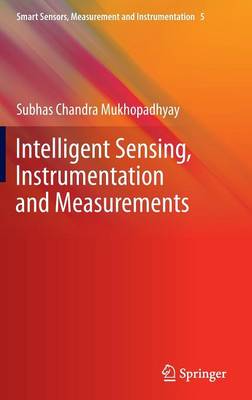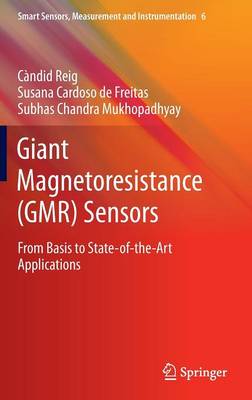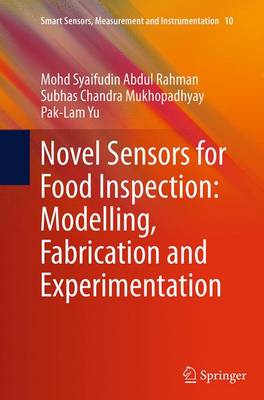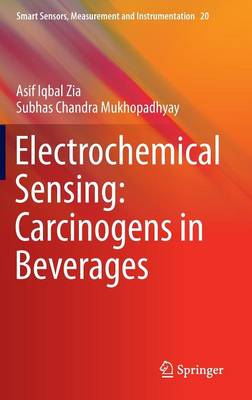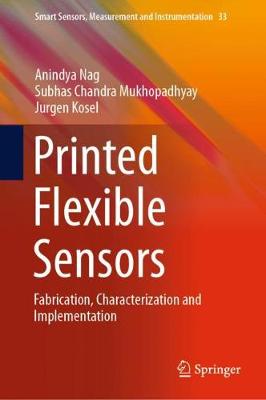Smart Sensors, Measurement and Instrumentation
8 primary works
Book 5
Intelligent Sensing, Instrumentation and Measurements
by Subhas Chandra Mukhopadhyay
"Intelligent Sensing, Instrumentation and Measurements" addresses issues towards the development of sensor nodes for wireless Sensor Networks. The fundamentals of sensors, interfacing, power supplies, configuration of sensor node, and GUI development are covered.
The book will be useful for engineers and researchers in the field ,especially for higher undergraduate and postgraduate students as well as practitioners working on the development of Wireless Sensor Networks or Smart Sensors.
Book 6
Giant Magnetoresistance (GMR) Sensors
by Candid Reig, Susana Cardoso, and Subhas Chandra Mukhopadhyay
Since the discovery of the giant magnetoresistance (GMR) effect in 1988, spintronics has been presented as a new technology paradigm, awarded by the Nobel Prize in Physics in 2007. Initially used in read heads of hard disk drives, and while disputing a piece of the market to the flash memories, GMR devices have broadened their range of usage by growing towards magnetic field sensing applications in a huge range of scenarios. Potential applications at the time of the discovery have become real in the last two decades. Definitively, GMR was born to stand.
In this sense, selected successful approaches of GMR based sensors in different applications: space, automotive, microelectronics, biotechnology ... are collected in the present book. While keeping a practical orientation, the fundamentals as well as the current trends and challenges of this technology are also analyzed. In this sense, state of the art contributions from academy and industry can be found through the contents.
This book can be used by starting researchers, postgraduate students and multidisciplinary scientists in order to have a reference text in this topical fascinating field.
Book 10
Novel Sensors for Food Inspection: Modelling, Fabrication and Experimentation
by Mohd Syaifudin Abdul Rahman, Subhas Chandra Mukhopadhyay, and Pak-Lam Yu
This book addresses presents recent developments of novel planar inter digital sensors for food inspection. It covers the fundamentals of sensors, their design, modelling and simulations, fabrications, characterizations, experimental investigations and analyses. This book will be useful for the engineers and researchers especially higher undergraduate, postgraduate students as well as practitioners working on the development of Electromagnetic Sensors.
Book 20
Electrochemical Sensing: Carcinogens in Beverages
by Asif Iqbal Zia and Subhas Chandra Mukhopadhyay
book describes a robust, low-cost electrochemical sensing system that is able to
detect hormones and phthalates - the most ubiquitous endocrine disruptor
compounds - in beverages and is sufficiently flexible to be readily coupled
with any existing chemical or biochemical sensing system. A novel type of silicon substrate-based smart interdigital
transducer, developed using
MEMS semiconductor fabrication technology, is employed in conjunction with electrochemical impedance spectroscopy to allow real-time detection and
analysis. Furthermore, the
presented interdigital capacitive sensor design offers a sufficient penetration
depth of the fringing electric field to permit bulk sample testing. The authors
address all aspects of the development of the system and fully explain its benefits.
The book will be of wide interest to engineers, scientists, and researchers
working in the fields of physical electrochemistry and biochemistry at the
undergraduate, postgraduate, and research levels. It will also be highly relevant
for practitioners and researchers involved in the development of electromagnetic
sensors.
Book 24
Wellness Protocol for Smart Homes
by Hemant Ghayvat and Subhas Chandra Mukhopadhyay
This book focuses on the development of wellness protocols for smart home monitoring, aiming to forecast the wellness of individuals living in ambient assisted living (AAL) environments. It describes in detail the design and implementation of heterogeneous wireless sensors and networks as applied to data mining and machine learning, which the protocols are based on. Further, it shows how these sensor and actuator nodes are deployed in the home environment, generating real-time data on object usage and other movements inside the home, and therefore demonstrates that the protocols have proven to offer a reliable, efficient, flexible, and economical solution for smart home systems.
Documenting the approach from sensor to decision making and information generation, the book addresses various issues concerning interference mitigation, errors, security and large data handling. As such, it offers a valuable resource for researchers, students and practitioners interested in interdisciplinary studies at the intersection of wireless sensing processing, radio communication, the Internet of Things and machine learning, and in how they can be applied to smart home monitoring and assisted living environments.Book 33
Printed Flexible Sensors
by Anindya Nag, Subhas Chandra Mukhopadhyay, and Jurgen Kosel
This book presents recent advances in the design, fabrication and implementation of flexible printed sensors. It explores a range of materials for developing the electrode and substrate parts of the sensors, on the basis of their electrical and mechanical characteristics. The sensors were processed using laser cutting and 3D printing techniques, and the sensors developed were employed in a number of healthcare, environmental and industrial applications, including: monitoring of physiological movements, respiration, salinity and nitrate measurement, and tactile sensing. The type of sensor selected for each application depended on its dimensions, robustness and sensitivity. The sensors fabricated were also embedded in an IoT-based system, allowing them to be integrated into real-time applications.
Book 35
This book presents the design and development of an Internet of Things (IoT) enabled, smart sensor to detect nitrate contamination in natural water. It considers three different sensors designed, fabricated and configured for nitrate detection: a Graphite/PDMS and Si-based MEMS sensors, and aFR4-based sensor. It also introduces a selective polymer material developed by means of the ion imprinting polymerization technique that was used as a coating on the Si-based MEMS sensor. Further, the book discusses the development of a smart sensing system that can be used to remotely monitor the nitrate concentration in any water. Fully explaining all the techniques used, the book is of interest to engineers, researchers and scientists working in the field of the water-quality measurement.
Book 41
IoT System Design
by Alice James, Avishkar Seth, and Subhas Chandra Mukhopadhyay
This book presents a step by step design approach to develop and implement an IoT system starting from sensor, interfacing to embedded processor, wireless communication, uploading measured data to cloud including data visualization along with machine learnings and artificial intelligence. The book will be extremely useful towards a hands-on approach of designing and fabricating an IoT system especially for upper undergraduate, master and PhD students, researchers, engineers and practitioners.
